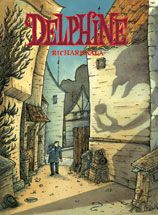- Comics
- Comics Reviews
- Manga
- Comics Reviews
- European Comics
- News
- Comics News
- Press Releases
- Columns
- Spotlight
- Digital Comics
- Webcomics
- Cult Favorite
- Back Issues
- Webcomics
- Movies
- Toys
- Store
- More
- About
By Leroy Douresseaux
January 16, 2007 - 13:40
 |
DELPHINE #1
FANTAGRAPHICS BOOKS/COCONINO Press
CARTOONIST: Richard Sala
ISBN-13: 978-1-56097-822-0
32 pp., B&W, 8½ x 11, $7.95
Delphine #1 by Richard Sala ( Evil Eye) is the 13th book in the Ignatz series, a line of comic books that Seattle Washington's Fantagraphics Books and Italy's Coconino Press are co-publishing. Ignatz's roster of cartoonists and creators is international in scope. Each individual Ignatz comic book is printed on heavy paper with cardstock covers in an oversized two-color format. Ignatz titles are part book, part magazine, part comic book (pamphlet), and part serialized graphic novel, and like a book, each edition in the line has a dust jacket. The oversized publishing format makes this look like a magazine, but the contents are all comic book.
In the first issue of Delphine, an unnamed young man disembarks from a train and finds himself in a rustic village that is surrounded by an ominous black forest. A university student, the young man is looking for a young co-ed with whom he's smitten. Her name is Delphine Penny, and the first time he asks for directions to her home (in a creepy wig shop), he gets a violent reaction. Soon, he's whisked out of town by a grumpy old man who offers to take him to Penny's address, but he eventually finds nothing but abandonment and a cast of way-too-sinister townsfolk.
Delphine is apparently Richard Sala's retelling of Snow White, but from the perspective of Prince Charming. A detail from the cover of issue one and an incident early in the narrative are the most obvious references to Snow White. The joy, however, will be less in the reworking of that particular fairy tale, and more about the experience of Sala's unique style and execution of storytelling.
He's been favorable compared to Edward Gorey and famed New Yorker cartoonist, Charles Addams, and I've even compared his visual style to filmmaker Tim Burton. Sala's writes mystery stories fully dressed in the trappings of dark fantasy and horror. Like the best horror stories, his characters often blithely saunter into mysterious small towns and villages or isolated peculiar locales, or even find mystery in their backyards. With a stiff upper lip, they doggedly pursue answers and often end up battling adversaries right out of fairy tales, myths, and B-movies.
Visually, it's easy to see why Sala draws comparisons to Gorey and Adams, and his art bears more than a passing resemblance to the films of Tim Burton, James Whale, and producer Val Lewton. The atmosphere of Sala's work is sometimes similar to the "Ichabod Crane" sequence of Walt Disney's animated package film, The Adventures of Ichabod and Mr. Toad.
Does this amount to anything? Yes, Sala's cartoons are engaging, darkly sweet confections with a hint of pop gothic. He's whimsical and macabre and puts a wry spin on terror. He's a natural born storyteller, but does with the pen and cartoons what the best oral storytellers do with the color, nuance, and tone of their voices - transport the listener to new worlds. Like the best comix and storytellers, Sala's work also sticks with you and leaves you wanting more.